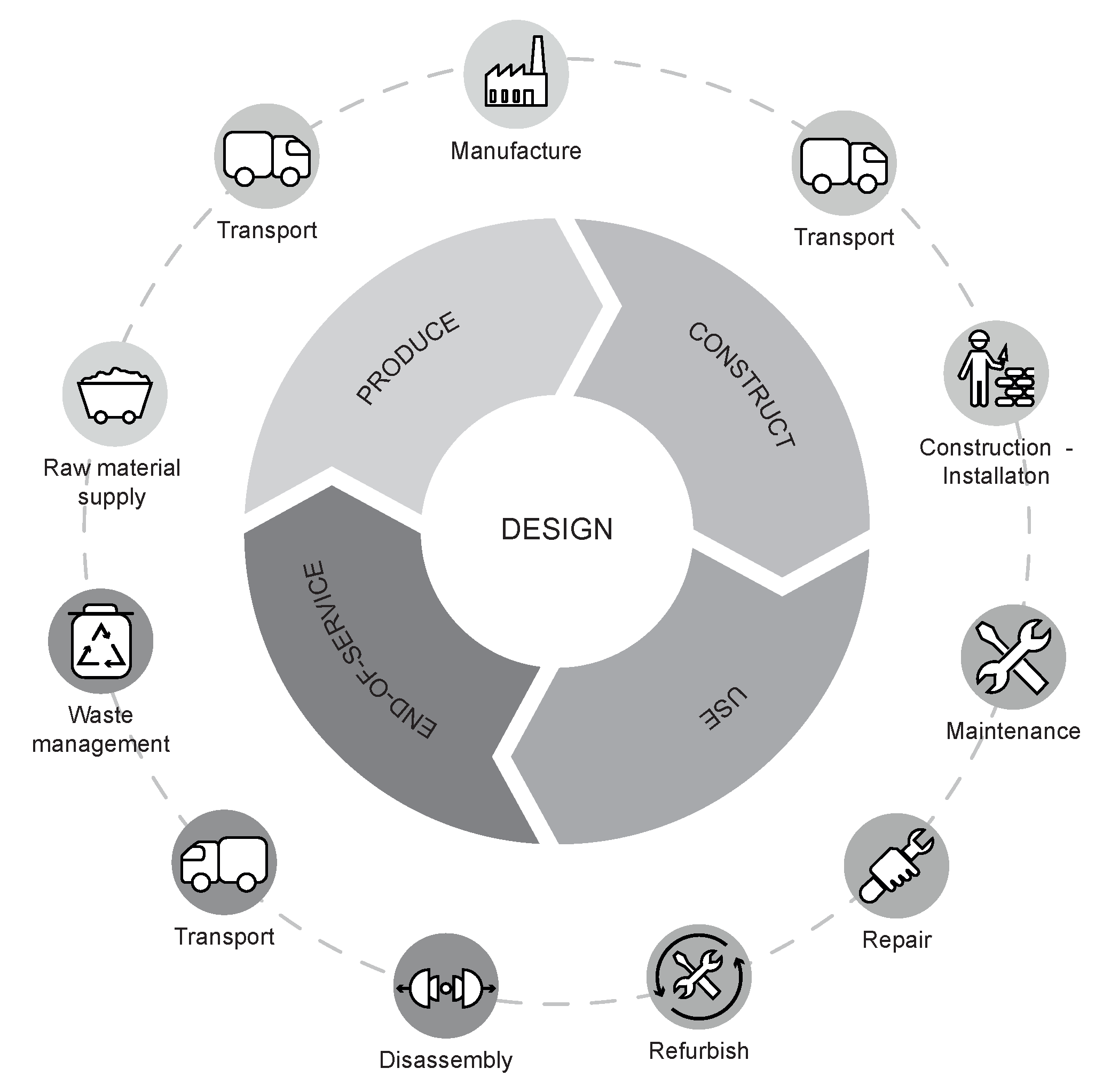3.1.2 Life-Cycle of a Building
Course subject(s)
Module 3. Building

In module 2 you learned about the different life-cycle stages of clay bricks. In the case of a whole building, it becomes more complex, but the logic stays the same.
If our goal, as designers and developers of a sustainable built environment, is to design waste out of the building’s life-cycle, it is important to understand the environmental impact of the different life-cycle stages. You can make more impact if you do not just think about the use stage of a building, but also about the production, construction and end-of-service stage during the design of a building. It is also crucial to understand which stakeholders are involved per stage because multidisciplinary collaboration is key within the circular economy.
We divide a building’s life-cycle into four different stages: production stage, construction stage, use stage, and end-of-life stage. In the end-of-service the materials can become an environmental burden or have positive impact by feeding them back to the production stage, reducing the extraction of raw materials.
During the production stage, raw materials are extracted, transported and converted into construction materials. The extraction of natural resources has a great impact on the availability of non-renewable resource and might lead to their depletion. Besides, a large amount of water and energy are related to this process. The manufacturing of construction products also requires a large amount of energy as it has been estimated that the construction materials production industry is one of the biggest energy consumer at a global level. Moreover, energy consumption leads to the release of air pollutants.
The construction stage is when the building takes its form. The construction stage of a building requires a considerable amount of energy and materials, and involves a high number of stakeholders.
The use stage is usually considered as the longest in the building life-cycle. This stage includes activities such as maintenance, and it is characterized by circular strategies such as reuse, repair and refurbish to extend the life span of the building. The use stage leads to environmental impact caused by the users and the physical characteristics of the building, i.e. energy and water use and waste generation.
The end-of-service stage in the context of the Circular Economy would mean that the buildings can be safely disassembled into different components, hence they can be reused, repaired, remanufactured or recycled. Since we live in a Linear Economy, the end-of-life of buildings is the demolition process. Demolition creates huge quantities of bulk waste which might be reused, recycled or simply landfilled. The environmental impact from this phase is related to the release of green gas emissions from machinery and transportation, as well as emissions related to landfill disposal.
EXTRA READING MATERIALS (OPTIONAL)
If you are interested in the topic of assessment of the environmental impact caused by the different life-cycle stages of the buildings you might find interesting the following list with additional reading materials (open-source) related to the Life Cycle Assessment (LCA) of buildings:
- Birgisdóttir, H. and Rasmussen, F. (2016). Introduction to LCA of Buildings. 1st edition. [online] Copenhagen: Danish Transport and Construction Agency. Available at: www.trafikstyrelsen.dk.
- Gardner, H., Garcia, J., Hasik, V., Olinzock, M., Banawi, A. and Bilec, M. (2019). Materials life cycle assessment of a living building. Procedia CIRP, [online] 80, pp.458-463. Available at www.elsevier.com.
- Petrovic, B., Myhren, J., Zhang, X., Wallhagen, M. and Eriksson, O. (2019). DLife Cycle Assessment of Building Materials for a Single-family House in Sweden. Energy Procedia, [online] 158, pp.3547-3552. Available at www.elsevier.com.

Circular Economy for a Sustainable Built Environment by TU Delft OpenCourseWare is licensed under a Creative Commons Attribution-NonCommercial-ShareAlike 4.0 International License.
Based on a work at https://online-learning.tudelft.nl/courses/circular-economy-for-a-sustainable-built-environment//.



